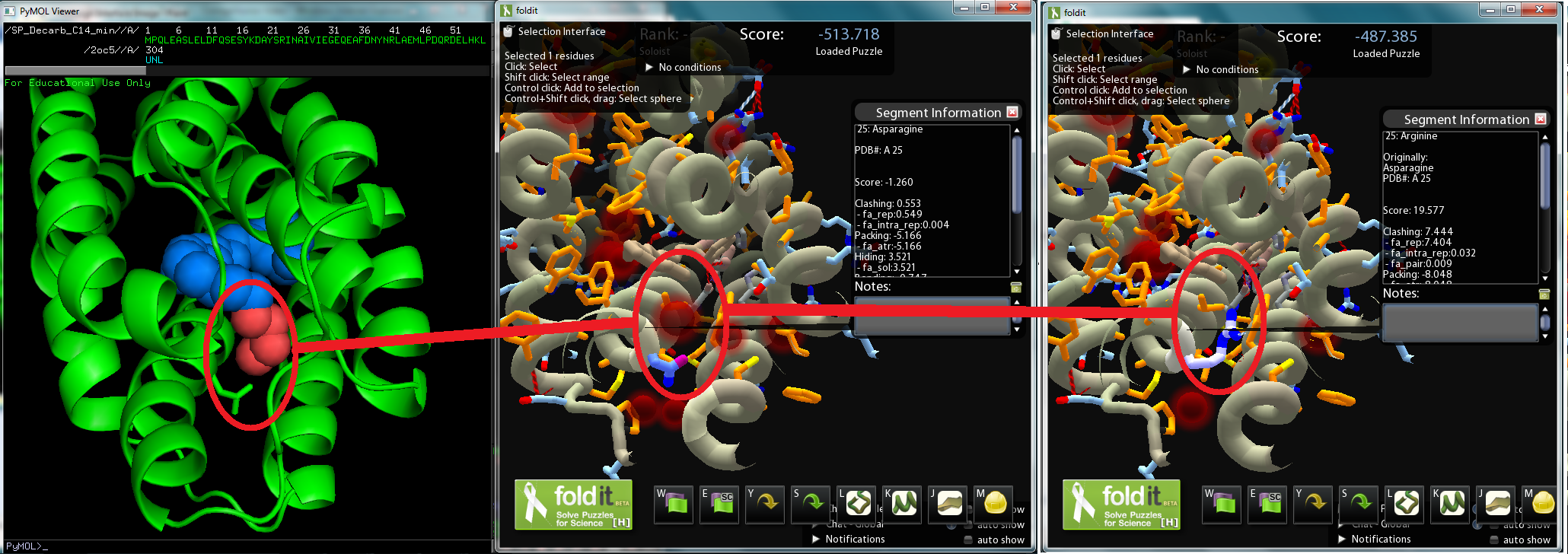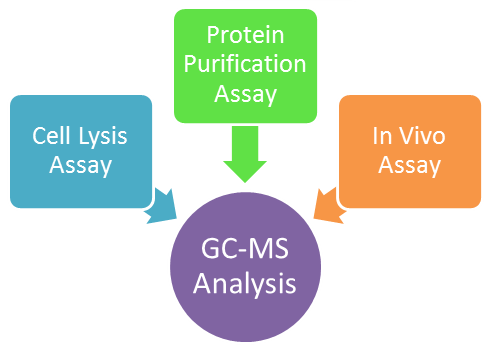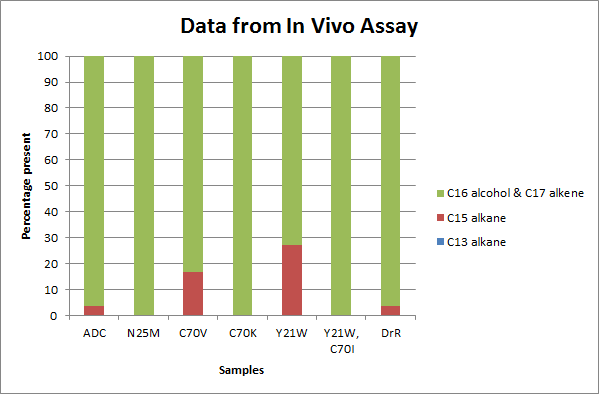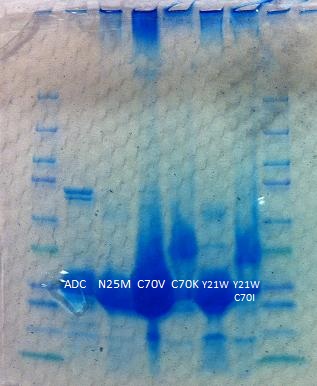Team:Washington/Alkanes/Future/DecarbDesign
From 2011.igem.org
DECARBONYLASE REDESIGN
Background
- Alkane biosynthesis, as it is, is mainly limited by ADC’s activity. In an effort to diversify alkane production, we strived to improve ADC’s activity on shorter fatty aldehydes.
- A crystal structure derived model of ADC was put on a Pymol file and reveals a octadecanoic acid stuck in the protein. The octadecanoic acid was modified to a tetradecanal, and then the Pymol file was converted to a Fold-it file for human interaction. On Fold-it, we can model mutations of amino acids in the enzyme and Fold-it computes a relative value representing the enzyme’s stability. As we wanted to maintain the aldehyde decarbonylation, we avoided changing amino acids near the catalytic iron center that binds to the aldehyde group.
- The most promising mutation sites seem to be amino acids 21 to 25 and 67 to 71, sections of two α-helices adjacent to the tetradecanal's carbon end; by mutating those amino acids to ones with larger side-chains, tetradecanal might fit better in ADC.
Methods
After using Fold-It, a computational design program, to model several ADC mutants, the ADC mutants were made using Kunkel Mutagenesis. The sequences of these mutants were later verified to carry the correct mutations. After creating several ADC mutants, three different types of assays were developed and the mutants were later tested and analyzed using Gas chromatography–mass spectrometry (GC-MS) to see if our mutants can produce more C13 alkanes. Three different assays were set up: cell lysis assay, protein purification assay, and in vivo assay.
In Vitro Assays
In these assays, ADC was cloned into a vector with an inducible promoter and Kanamycin resistance.
- Cell Lysis Assay
One aldehyde decarbonylase (ADC) colony was picked and grown in the 37°C shaker until OD600 reached the value of 0.8. Then, the culture was induced with IPTG and cell pellet was collected by spinning down after three more hours of shaking. This cell pellet was resuspended in a solution that contains sodium phosphate buffer, protease inhibitor, DNAses and lysozyme. The resuspended cells were lysed with 10% triton then centrifuged. The supernatant was transferred to a glass vial and used to set up in vitro reactions. In vitro reactions were set up by adding certain volume of cells, feredoxin, feredoxin reductase, NADPH and aldehyde. However, this assay did not yield consistent alkane production every time even though we kept variables very minimal. So our team decided to move on and develop a different assay, protein purification assay.
- Protein Purification Assay
We decided to increase the concentration of ADC and decrease the number of contaminants in the assay. We grow up cells to express 10 times more ADC proteins and then we purify the proteins by lysing the cells and binding the target ADC proteins to the BioRad columns and then eluting them out, resulting in pure ADC proteins. Then, we setted up in vitro reactions by adding purified ADC mutant protein, standard buffer(Hepes at pH8, NaCl, glycerol, TCEP and water) and feredoxin, feredoxin reductase, NADPH, and aldehyde into an eppendorf. After certain time period has passed, it was quenched in ethyl acetate and the top organic layer that results from quencing was extracted to an insert in a GC-MS vial. This was later analyzed in the GC-MS.
- With only a week or two (at most) left of experiment time, we basically have to give up on a second round of mutations. Also, the GCMS results with the purified proteins showed no alkane (product of reaction) peaks at all. This could be explained by the fact that the freezer in which we stored glycerol stocks of our purified protein was actually -25C instead of the displayed -50C. However, since we did not know when the freezer began malfunctioning, so it may be just as likely that aldehyde decarbonylase cannot be stored and reused. So we moved onto working with in vivo assay which we started to develop at the same time we started to work on protein purification assay.
In Vivo Assay
We took the base construct RED-PSB1C3 (Acyl-ACP Reductase in PSB1C3 high constitutive vector) and made the 1C3-const-RED-rbs-mutant decarb construct (1C3 construct with RED, ribosomal binding site, and the mutant decarbonylase genes made with Kunkel (site directed) mutagenesis. Then we transformed the competent cells (BL-21) to take up construct plasmids with our mutated ADC genes. We then grow the transformed competent cells in TB with chloramphenicol and then plate it on TB-chloramphenicol agar plates. Individual colonies were taken to inoculate water, and the colony waters were taken to run colony PCRs to confirm the uptake of the correct plasmid constructs that are with mutated ADC genes. Once verified, the corresponding colony waters of the successful colonies were grown in TB-chloramphenicol media overnight. The media are then miniprepped to obtain DNA of the original plasmid construct taken up by BL-21. The miniprepped plasmid construct is then transformed into another form of the competent cells (MG1655) and then plated on TB-chloramphenicol agar to have samples of different genetic variety of samples. Six isolated colonies are picked on each plate (to average out genetic differences) to be grown in special alkane production media M9 for 48 hours. After that, alkane is extracted with ethyl acetate and the samples are then analyzed with GCMS machine.
In vivo (in the cell, start from glucose) : cells’ membrane will keep proteins in smaller volume, but the main point is that we can compare with native ADC cell results from other groups (the cells probably will make more alcohol anyway).
Current Status/Results
We made 5 mutants, all in the location of the ADC gene. They are: 1C2 7A5 8BE 9A1 10B5
Above is the protein gel ran after purifying aldehyde decarbonylase (ADC). Because there isn't a continuous band of proteins, it indicates that we got rid of insoluble proteins and other larger soluble proteins to get a purer sample of ADC.
- Discuss mutations made and construct submitted
- Show protein gel of expression
- strong possibility that ADC does not store well, suggest testing to see if feasible with -80 freezer.
- Discuss in vitro assay and how it hasn't worked yet (even for WT)
- Discuss plan for future testing
While the mutations definitely showed altered substrate specificity due to different ratios of activity, due to the construct's low or even lacking production on C13 alkanes, the in vivo assay does not say for sure if the specificity was skewed toward shorter or longer aldehyde decarbonylation.
From our experience, if one's sole purpose is to test mutants, the best thing to do is use a purified protein assay with C14 aldehydes to test improved activity, then characterize the wild type ADC and promising mutant with C16 aldehyde assays and C18 aldehyde assays. An in vivo assay may work if LuxCDE constructs are made, as LuxCDE reportedly produces a C14 aldehyde.
Parts Submitted
Aldehyde Decrabonylase Redesign team has submitted six parts to the registry: Wild-type Aldehyde Decarbonylase and five of our mutants. A short description for each part is provided below.
BBa_K590053: RrD_PSB1c3-High constitutive vector
BBa_K590054: RrD_N25M-PSB1c3-High constitutive vector
BBa_K590055: RrD_C70V-PSB1c3-High constitutive vector
BBa_K590056: RrD_C70K-PSB1c3-High constitutive vector
BBa_K590057: RrD_Y21W-PSB1c3-High constitutive vector
BBa_K590058: RrD_Y21W,C70I-PSB1c3-High constitutive vector
 "
"






